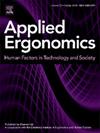Improving dynamic endurance time predictions for shoulder fatigue: A comparative evaluation
IF 3.1
2区 工程技术
Q2 ENGINEERING, INDUSTRIAL
引用次数: 0
Abstract
Work-related musculoskeletal disorders (WMSDs) are commonplace in industry and a host of qualitative and quantitative approaches have been used to assuage the problem, including wearable sensors and biomechanical endurance models, both of which were used in the present study. Six endurance models (consumed endurance, new improved consumed endurance and the exponential and power Frey Law and Avin general and shoulder models) with four alternative maximum torque () quantification methods, including a novel approach to generate , were compared. The proposed approach to quantify , in combination with the new improved consumed endurance model produced the lowest root mean square errors (RMSE), and indicated improved performance compared to the literature. The mean RMSE was reduced from 41.08s to 19.11s for all subjects, from 26.13s to 12.16s for males, and 51.28s to 24.45s for females using the proposed method. R2 for 25% and 45% standardised intensity dynamic tasks were .459 and .314 respectively, P < .01. This research provided an optimised and individualised endurance prediction approach for loaded dynamic movements which can be applied to industry tasks and may lead to reduced upper-limb strains, and potentially WMSDs.
改进肩部疲劳的动态耐力时间预测:一个比较评价
与工作相关的肌肉骨骼疾病(WMSDs)在工业中很常见,许多定性和定量的方法已经被用来缓解这个问题,包括可穿戴传感器和生物力学耐力模型,这两种方法都被用于本研究。比较了6种耐力模型(消耗耐力、新型改进的消耗耐力、指数和功率Frey定律和Avin一般模型和肩部模型)和4种可选的最大扭矩(Torquemax)量化方法,包括一种新的产生Torquemax的方法。所提出的量化Torquemax的方法与新的改进的消耗耐力模型相结合,产生了最低的均方根误差(RMSE),与文献相比,表明性能有所提高。使用所提出的方法,所有受试者的平均RMSE从41.08s降至19.11s,男性从26.13s降至12.16s,女性从51.28s降至24.45s。25%和45%标准化强度动态任务的R2分别为0.459和0.314,P <;. 01。该研究为负载动态运动提供了一种优化的个性化耐力预测方法,可应用于工业任务,并可能减少上肢劳损,以及潜在的WMSDs。
本文章由计算机程序翻译,如有差异,请以英文原文为准。
求助全文
约1分钟内获得全文
求助全文
来源期刊

Applied Ergonomics
工程技术-工程:工业
CiteScore
7.50
自引率
9.40%
发文量
248
审稿时长
53 days
期刊介绍:
Applied Ergonomics is aimed at ergonomists and all those interested in applying ergonomics/human factors in the design, planning and management of technical and social systems at work or leisure. Readership is truly international with subscribers in over 50 countries. Professionals for whom Applied Ergonomics is of interest include: ergonomists, designers, industrial engineers, health and safety specialists, systems engineers, design engineers, organizational psychologists, occupational health specialists and human-computer interaction specialists.
 求助内容:
求助内容: 应助结果提醒方式:
应助结果提醒方式:


